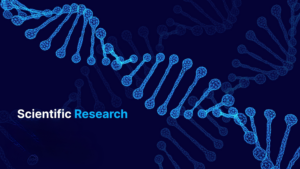The remnants of ancient viral infections are littered across the human genome. Many of these relics, known as transposable elements (TE), are believed to have brought cryptic promoters, enhancers, and other regulatory elements into the human genome with the potential to dramatically alter the expression of nearby genes [1, 2]. Yet, like unexploded ordinances on a long forgotten battlefield, most TE lay dormant, buried under repressive epigenetic marks that ensure their influence over cell behaviour remains minimal. When they awaken, however, the consequences can be far reaching.
One such consequence is the enablement of malignant transformation. This phenomenon is known as onco-exaptation, wherein cancer cells benefit from the activation of previously dormant TE [3, 4]. This type of reawakening has been described in many tumour types, with one study reporting the presence of onco-exaptation in as many as 50% of tumours [3]. Similar findings suggest that the abnormal activation of TE may play an important role in neurodegenerative, autoimmune, and inflammatory conditions [5].
It is increasingly clear that healthy cells protect themselves from these conditions by selectively burying TE in heterochromatin, effectively suppressing their pathological effects. However, the ways in which cells maintain this protection—and why they sometimes fail—is poorly understood.
New findings reported in Nature Structural & Molecular Biology shed light on this mystery, drawing attention to the proteins that till the epigenetic landscape and the pathology of abnormal DNA methylation.
Protection by DNA Methylation
The epigenetic landscape is a simple term that describes a complex network of regulatory systems, each of which helps cells establish a stable gene expression profile without altering its underlying genome [6]. This can take the form of histone modifications that dictate how tightly DNA is wound around nucleosomes, thereby influencing a gene’s availability to transcriptional machinery. Another form of epigenetic regulation lies in DNA methylation. When DNA methyltransferase (DNMT) proteins add a methyl group to the 5th carbon in cytosine bases (forming a modified base known as 5mC), DNA becomes less likely to bind transcription factors and more likely to recruit repressive protein complexes [7].
Collectively, epigenetic marks like 5mC decorate the human genome in tissue- and cell-specific patterns, enabling cells to take on distinct identities despite inheriting the same genome. However, some portions of the genome are placed under a particularly intensive form of lockdown known as heterochromatin. Genes and regulatory sequences in these portions of DNA are strongly suppressed by extensive histone modifications and prolific DNA methylation. Dormant TEs are often buried safely within the silence of heterochromatin.
The maintenance of these long-term heterochromatic regions is believed to be critical for genomic stability [8]. But to do this, cells must not only blanket the region with 5mC, but they must also actively prevent its demethylation by ten-eleven translocase (TET) enzymes. This family of proteins oxidises 5mC, forming a stable intermediate known as 5-hydroxy methylcytosine (5hmC) which is subsequently removed and replaced with an unmodified cytosine base through DNA repair mechanisms. The balance between DNMT and TET protein activity helps maintain appropriate levels of methylation and the preservation of genomic stability [9, 10].
However, balance is not always maintained. A growing body of evidence suggests that an early step in disease development is the progressive removal of DNA methylation from heterochromatin and the subsequent activation of the TE contained within it [9, 11, 12]. Uncovering how and why this balance becomes skewed is of significant interest, as it may point to novel biomarkers for early disease detection and uncover new therapeutic targets.
The OGT-TET Connection
In a recently published article, Sepulveda et al. described a novel mechanism by which cells maintain appropriate methylation levels. Their study focused on an enzyme known as O-GlcNAc transferase (OGT), which is known to attach N-acetylglucosamine (GlcNAc) to the serine/threonine residues of many nuclear and cytoplasmic proteins, including all three TET protein family members. The consequences of OGT’s interaction with TET, however, remain unknown. Sepulveda et al. hypothesized that this interaction curtails TET activity and prevents pathological DNA demethylation.
To test this hypothesis, the team used mouse embryonic stem cells (mESCs) that had previously been engineered with an inducible knockout system. Upon treatment with 4-OHT, the OGT gene is excised from the genome, resulting in complete knockout.
The result of OGT knockout on DNA methylation was striking. Genome-wide bisulfite sequencing revealed a significant drop in methylation levels across the genome, consistent with increased activity from TET enzymes. To rule out the possibility that methylation levels were dropping through passive (dilution-based) means, the team leveraged a new technology known as duet evoC, a multi omics solution enabling 6-base sequencing from biomodal which allows them to analyze the levels of 5mC and 5hmC following OGT knockout. Results showed that loss of 5mC across the genome often correlated with a rise in 5hmC, indicating that demethylation was occurring through active (TET-mediated) processes*.
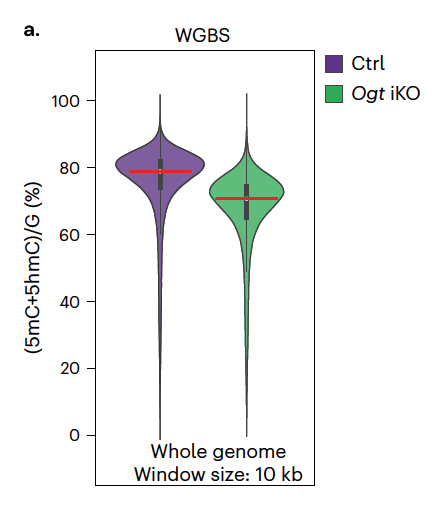
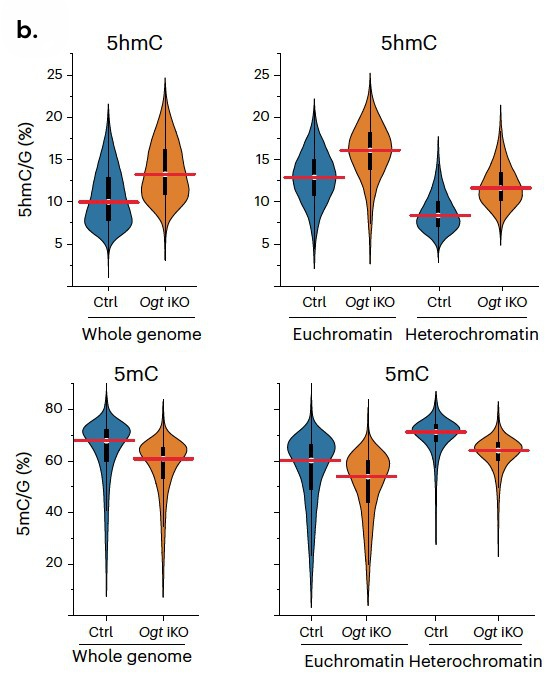
Figure 1: (a) Violin plots showing global loss of DNA methylation in Ctrl Ogt fl mES cells and Ogt iKO mES cells measured by Whole Genome Bisulfite Sequencing; (b) Violin plots showing increased 5hmC (top) and decreased 5mC (bottom) in Ogt iKO compared with Ogt fl (Ctrl) mES cells at whole-genome resolution (left) or by chromatin compartments (right), data generated using biomodal’s duet evoC technology to simultaneously detect 5mC, 5hmC and the canonical bases A, C, G and T at base resolution in a single sequencing run.
Notably, 5hmC levels were significantly increased in heterochromatic regions following OGT knockout. Examination of gene expression profiles in OGT knockout cells revealed a stark upregulation of TE across the genome, including many in heterochromatic regions—specifically endogenous retroviruses (ERVs), intracisternal A-type particles (IAP) retrotransposons, and a family of long interspersed elements (L1). Unsurprisingly, this upregulation of TE activity correlated with loss of 5mC and gain of 5hmC at their respective genomic loci.


above: TE-expression (log2 ratio)
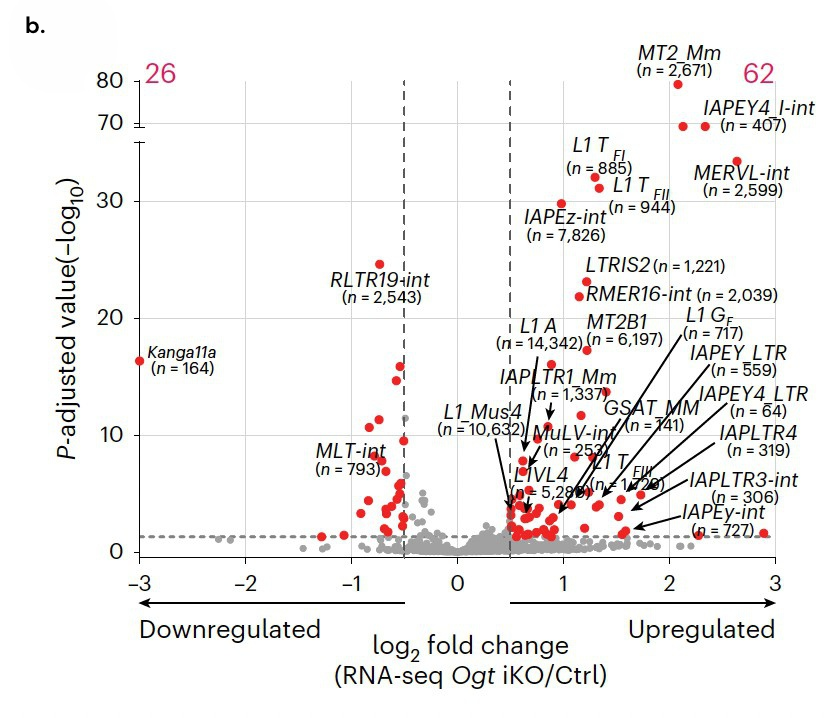
Figure 2: (a) RNA-seq data of Ogt iKO versus Ctrl Ogt fl mES cells, analysed for differential expression of uniquely mapped TEs (log FC) ±1, P value <0.05). Left: numbers of upregulated (red) or downregulated (grey) TEs in each family. Right: data for the youngest members of each family (b) Volcano plot of RNA-seq data showing differential TE expression in Ogt iKO relative to Ctrl Ogt fl mES cells. The number of individual copies analysed for each TE subfamily is shown in parentheses. The red dots indicate transcripts exhibiting an at least twofold change in expression (log fold change (log FC) of ±1) and P-adjusted value <0.05 (using the Benjamini–Hochberg test).
Additionally, OGT deletion was also associated with a striking upregulation of interferon-stimulated genes (ISGs). Gene set enrichment analyses showed that, among the 1,661 upregulated genes in OGT knockout cells, there was a strong enrichment for genes involved in inflammatory response pathways and response to viruses.
Together, the results of this study paint an interesting picture of epigenetic regulation and influence, wherein OGT inhibits TET protein activity, allowing DNMT to suppress TE expression and, perhaps indirectly, inflammatory signaling.
*Similar results were found using parallel models, in which OGT was pharmacologically inhibited, as well as studies involving TET proteins that are unable to bind with OGT due to a point mutation (D2108A). In these studies, levels of 5hmC were notably higher when the OGT-TET interaction was disrupted.Implications of A New Regulatory Axis
Collectively, these results shine a spotlight on the regulatory axis that exists between DNMT, TET, and OGT proteins. It appears that OGT proteins restrain TET-mediated DNA demethylation, which in turn supports the ongoing suppression of TE by DNMT. This finding has several important implications.
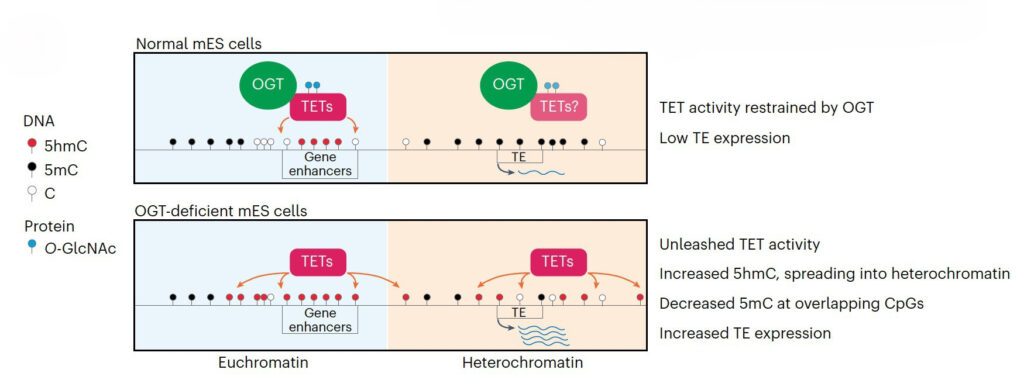
Figure 3: Model illustrating the increase of TET activity in both euchromatin and heterochromatin after Ogt deletion. Ogt iKO mES cells lose O-GlcNAcylation and show a substantial decrease of DNMT1 and UHRF1. The genome-wide constraint imposed by OGT on TET activity in WT mES cells is unleashed upon OGT deletion, leading to a rapid genome-wide increase in 5hmC and concomitant decrease of 5mC in both euchromatic and heterochromatic compartments. The decrease of 5mC at the regulatory and transcribed regions of TEs, particularly those in heterochromatin, is accompanied by a striking increase in TE expression in OGT-deficient mES cells.
Sepulveda et al show that dysregulation of TET proteins can lead to the demethylation of heterochromatin and the expression of several TE. This suggests that mutations disrupting or obviating the OGT-TET interaction may significantly predispose patients to genomic instability and its associated diseases, such as cancer, Alzheimer’s and others [8, 9].
It is notable, therefore, that DNMT3A, TET2, and ASXL1 are the three most frequently mutated proteins in a premalignant condition known as clonal hematopoiesis, which is associated with aging, inflammation, and cardiovascular disease [13]. And, as Sepulveda et al demonstrated, both TET2 and ASXL1 proteins robustly interact with OGT. It is conceivable then that mutations affecting interactions between OGT and its binding partners, like TET2 and ASXL1, set the stage for disease development.
Additionally, Sepulveda et al’s use of 6-base sequencing revealed important nuances to the demethylation process. Had they relied solely on traditional whole genome bisulfite sequencing—which provides information on total modified cytosine (5mC + 5hmC)—they would still have been able to see the hypomethylation that occurs following OGT knockout. But they would have missed the increased levels of 5hmC that occurred in heterochromatic regions. In observing this, Sepulveda et al. provide evidence that 5hmC formation in heterochromatin may forecast the onset of hypomethylation as well as the pathological expression of TE. As 5hmC may be measured in both tissue and liquid biopsies [14], the insights provided by Sepulveda et all suggest that 5hmC may be a valuable biomarker for early disease development.
You can now read Sepulveda et al.’s full paper in Nature Structural & Molecular Biology: OGT prevents DNA demethylation and suppresses the expression of transposable elements in heterochromatin by restraining TET activity genome-wide.
Learn more about 6-base sequencing.
References
- Pray, Leslie. “Transposons | Learn Science at Scitable.” Nature.com, 2008, www.nature.com/scitable/topicpage/transposons-the-jumping-genes-518/.
- Bourque, Guillaume, et al. “Ten Things You Should Know about Transposable Elements.” Genome Biology, vol. 19, no. 1, 19 Nov. 2018, https://doi.org/10.1186/s13059-018-1577-z.
- Jang, Hyo Sik, et al. “Transposable Elements Drive Widespread Expression of Oncogenes in Human Cancers.” Nature Genetics, vol. 51, no. 4, 1 Apr. 2019, pp. 611–617, https://doi.org/10.1038/s41588-019-0373-3.
- Babaian, Artem, and Dixie L. Mager. “Endogenous Retroviral Promoter Exaptation in Human Cancer.” Mobile DNA, vol. 7, no. 1, Dec. 2016, https://doi.org/10.1186/s13100-016-0080-x.
- Payer, Lindsay M., and Kathleen H. Burns. “Transposable Elements in Human Genetic Disease.” Nature Reviews Genetics, vol. 20, no. 12, 1 Dec. 2019, pp. 760–772, https://doi.org/10.1038/s41576-019-0165-8.
- Cavalli, Giacomo, and Edith Heard. “Advances in Epigenetics Link Genetics to the Environment and Disease.” Nature, vol. 571, no. 7766, July 2019, pp. 489–499, https://doi.org/10.1038/s41586-019-1411-0.
- Moore, Lisa D, et al. “DNA Methylation and Its Basic Function.” Neuropsychopharmacology, vol. 38, no. 1, 11 July 2012, pp. 23–38, https://doi.org/10.1038/npp.2012.112.
- Janssen, Aniek, et al. “Heterochromatin: Guardian of the Genome.” Annual Review of Cell and Developmental Biology, vol. 34, no. 1, 6 Oct. 2018, pp. 265–288, https://doi.org/10.1146/annurev-cellbio-100617-062653.
- Pappalardo, Xena Giada, and Viviana Barra. “Losing DNA Methylation at Repetitive Elements and Breaking Bad.” Epigenetics & Chromatin, vol. 14, no. 1, 3 June 2021, https://doi.org/10.1186/s13072-021-00400-z.
- Davletgildeeva, Anastasiia T., and Nikita A. Kuznetsov. “The Role of DNMT Methyltransferases and TET Dioxygenases in the Maintenance of the DNA Methylation Level.” Biomolecules, vol. 14, no. 9, 4 Sept. 2024, p. 1117, https://doi.org/10.3390/biom14091117.
- Wilson, Ann S., et al. “DNA Hypomethylation and Human Diseases.” Biochimica et Biophysica Acta (BBA) – Reviews on Cancer, vol. 1775, no. 1, Jan. 2007, pp. 138–162, https://doi.org/10.1016/j.bbcan.2006.08.007.
- Hahn, Matthias, et al. “Heterochromatin Dysregulation in Human Diseases.” Journal of Applied Physiology (Bethesda, Md.: 1985), vol. 109, no. 1, 1 July 2010, pp. 232–242, https://doi.org/10.1152/japplphysiol.00053.2010.
- Jaiswal, Siddhartha, and Benjamin L. Ebert. “Clonal Hematopoiesis in Human Aging and Disease.” Science, vol. 366, no. 6465, 31 Oct. 2019, p. eaan4673, https://doi.org/10.1126/science.aan4673.
- Fabio Puddu, et al. “5-Methylcytosine and 5-Hydroxymethylcytosine Are Synergistic Biomarkers for Early Detection of Colorectal Cancer.” BioRxiv (Cold Spring Harbor Laboratory), 31 Oct. 2024, https://doi.org/10.1101/2024.10.30.621123.



